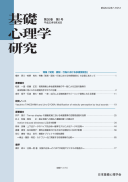Volume 12, Issue 2
Displaying 1-14 of 14 articles from this issue
- |<
- <
- 1
- >
- >|
-
Article type: Cover
1994 Volume 12 Issue 2 Pages Cover5-
Published: March 31, 1994
Released on J-STAGE: November 12, 2016
Download PDF (26K) -
Article type: Cover
1994 Volume 12 Issue 2 Pages Cover7-
Published: March 31, 1994
Released on J-STAGE: November 12, 2016
Download PDF (48K) -
Article type: Article
1994 Volume 12 Issue 2 Pages 71-76
Published: March 31, 1994
Released on J-STAGE: November 12, 2016
Download PDF (778K) -
Article type: Article
1994 Volume 12 Issue 2 Pages 77-83
Published: March 31, 1994
Released on J-STAGE: November 12, 2016
Download PDF (918K) -
Article type: Article
1994 Volume 12 Issue 2 Pages 85-97
Published: March 31, 1994
Released on J-STAGE: November 12, 2016
Download PDF (1681K) -
Article type: Article
1994 Volume 12 Issue 2 Pages 99-103
Published: March 31, 1994
Released on J-STAGE: November 12, 2016
Download PDF (614K) -
Article type: Article
1994 Volume 12 Issue 2 Pages 105-106
Published: March 31, 1994
Released on J-STAGE: November 12, 2016
Download PDF (349K) -
Article type: Article
1994 Volume 12 Issue 2 Pages 106-108
Published: March 31, 1994
Released on J-STAGE: November 12, 2016
Download PDF (516K) -
Article type: Article
1994 Volume 12 Issue 2 Pages 108-109
Published: March 31, 1994
Released on J-STAGE: November 12, 2016
Download PDF (364K) -
Article type: Article
1994 Volume 12 Issue 2 Pages 109-110
Published: March 31, 1994
Released on J-STAGE: November 12, 2016
Download PDF (324K) -
Article type: Article
1994 Volume 12 Issue 2 Pages 111-112
Published: March 31, 1994
Released on J-STAGE: November 12, 2016
Download PDF (335K) -
Article type: Article
1994 Volume 12 Issue 2 Pages 112-113
Published: March 31, 1994
Released on J-STAGE: November 12, 2016
Download PDF (340K) -
Article type: Article
1994 Volume 12 Issue 2 Pages 114-
Published: March 31, 1994
Released on J-STAGE: November 12, 2016
Download PDF (139K) -
Article type: Bibliography
1994 Volume 12 Issue 2 Pages 121-
Published: March 31, 1994
Released on J-STAGE: November 12, 2016
Download PDF (14K)
- |<
- <
- 1
- >
- >|
